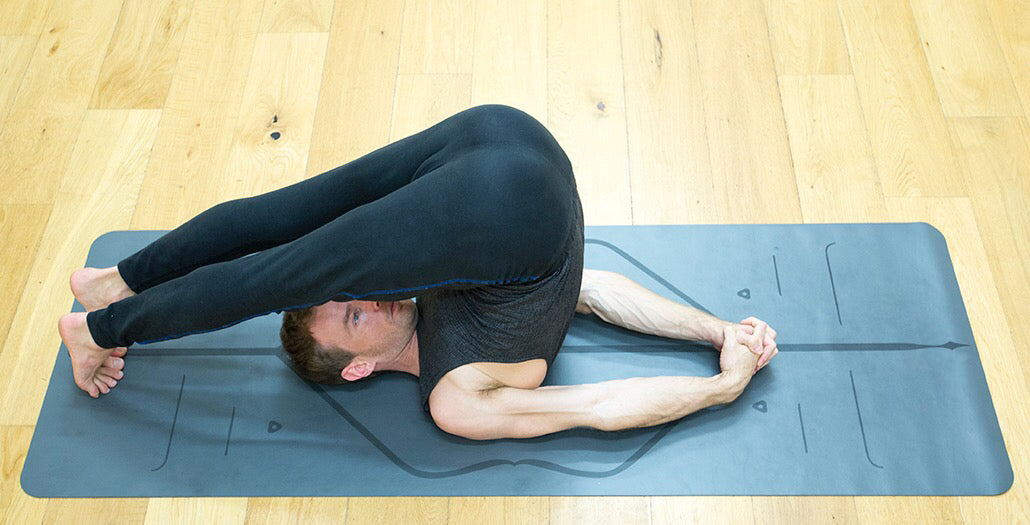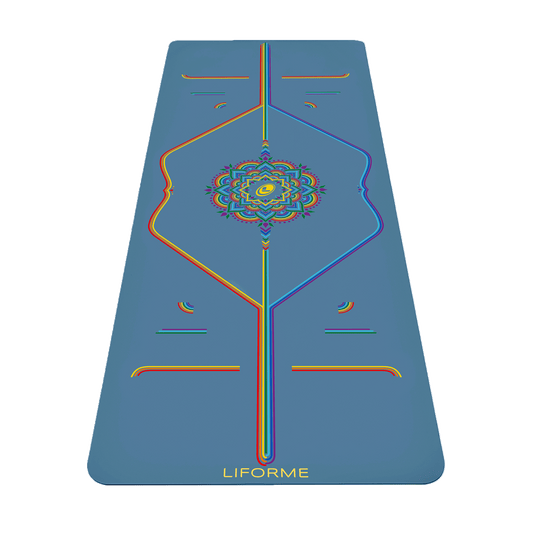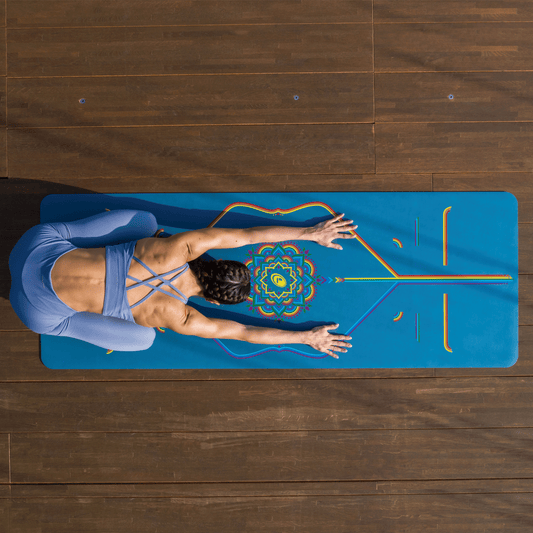Ahem. Cough, cough.
In order to speak your truth and be heard, you have to first clear your throat. In yoga, that means doing poses that open the Vishuddha chakra, which has its physical nexus in the neck. Each chakra is associated with a colour and a seed syllable. For Vishuddha, the colour is blue and the syllable is “HAM”. Visualising this colour and chanting the mantra “HAM” will also contribute to opening this chakra.
The following poses move the neck into extension and flexion. If you have previously had a neck injury or neck pain, make sure to talk with a healthcare professional to make sure you understand what types of movement you should avoid.
Warm up with Cat-Cows for your spine and the hamstring stretches of your choice. We like Triangle and Half Moon Pose.
Cat-Cow With Lion’s Breath

Cat-Cow stretches are wonderful preparation for any yoga asana practice because they introduce movement into your entire spine. As you move through Cow to Cat and back again, you’re articulating each joint along your spine from neck to tail and literally lubricating them.
1. On your inhales, lift your tail, drop your belly and look up. On your exhales, tuck your tail, arch your back and drop your head so that your gaze comes to your navel.
2. After a few rounds, begin to introduce Lion’s Breath on your exhalations. Inhale through the nose in Cow pose as usual. On your exhalations, let your Cat roar as you tone the back of your throat and exhale forcefully through your mouth, sticking your tongue out toward your chin. Move through several rounds of Lion-Cow to open your throat.
Plow Pose (Halasana)

If you know that your feet don’t reach the floor behind your head in Plow Pose, set up with a wall behind you to catch your feet. You may need to play around with your positioning a bit to find the right distance from the wall, which will vary for each individual.
1. Come to lie down on your back. Bring your legs up to a vertical position. Keep your arms by your sides with your palm facing down. On an inhalation, engage your core to lift your legs up and over your head. The balls of your feet should be on the floor or on the wall behind you. You don’t want to hover the feet off the floor in this position. You need their support.
2. Once your feet are situated, roll your shoulder blades under your back one at a time to puff up your chest toward your chin. With your arms straight, interlace your fingers behind your back and press your palms together. Ideally, your hips will be directly above your shoulders. Keep your head still.
Shoulderstand (Salamba Sarvangasana)

Release your hands and bend your elbows in order to bring your palms to your mid-back with the fingers pointing up.
1. Lift your legs to a vertical position one at a time. One of the most common problems in Shoulderstand is that the feet are over the face instead of over the hips. Do your best to correct this position or have a friend eyeball it for you. Don’t be tempted to look in the mirror because you don’t want to turn your head in this position. Keep your feet active. You can flex your feet, point your toes, or split the difference, which we call a floint of the toes.
2. If you’re new to Shoulderstand, keep the legs up for around 10 breaths or fewer. If you’re a little more experienced, you can hold a bit longer or experiment with other leg variations such as taking the legs wide or bringing the soles of the feet to touch in a Baddha Konasana position.
3. To come out, take your feet back behind your head through Plow. Then release your arms to your sides and slowly roll your spine back to the mat one vertebra at a time, bringing your legs along with you until you are lying flat on your back with your legs extended.
Fish Pose (Matsyasana)

From lying down, use your core to sit halfway up.
1. Bend your arms to support yourself, bringing your elbows under your shoulders with your forearms flat on the mat. On an inhalation, puff your chest up and draw your shoulder blades together on your back to make a little shelf for your heart.
2. Let your head drop back as you open your throat to the ceiling. Eventually, the crown of your head may come to rest on the floor but it’s fine if it doesn’t. Leaving the head hanging can actually allow for more spinal extension, so don’t compromise your backbend to get your head down to the ground. Engage your legs and flare through the toes.
3. To come out, slowly tuck your chin into your chest and release your arms to the floor to return to lying down flat.
An Important Note About Props:
Plow Pose and Shoulderstand can greatly benefit from the judicious use of props. In particular, we highly recommend using a folded blanket or two under the shoulder blades. This has the effect of supporting the maintenance of the natural curve of the cervical spine (also known as the neck). Without the blankets, the neck can end up with a lot of pressure on it, which causes the curve to flatten and increases your risk of injury.
Here’s how:
You’ll want two or three firm yoga blankets, each folded to make a rectangle about the width of your mat (i.e., how yoga blankets are usually folded for storage). If the blankets are uneven or rumpled, take a minute to refold everything so it lies neatly. Stack the folded blankets at the very end of your mat with the folded edges aligned with the back edge of the mat. When you come into the pose, the idea is to have your shoulders, upper back, and arms on the blankets while your head is actually on the floor. Placing your head on the floor allows it to easily slide as much as it needs to. So, set up for Plow or Shoulderstand with your shoulders on the blankets and your head on the floor, then come into the pose as described above. If you are doing Fish afterwards, you can move the blankets out of the way or keep them in place, whichever you prefer.
Love,
Liv x
Featured Yogis: @ambrasana & @davjonesyoga
Image credit: @fabiofilippi


 Practising Yoga poses that clear your throat chakra supports your intention to speak your truth and helps keep your neck (where a lot of tension is stored) looser and more mobile. Move through Cat-Cow, Plow, Shoulderstand, and Fish in this intermediate sequence.
Practising Yoga poses that clear your throat chakra supports your intention to speak your truth and helps keep your neck (where a lot of tension is stored) looser and more mobile. Move through Cat-Cow, Plow, Shoulderstand, and Fish in this intermediate sequence.


































